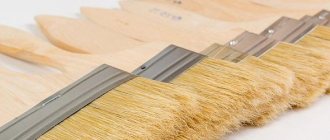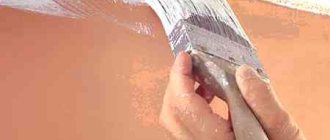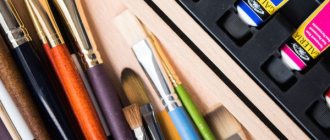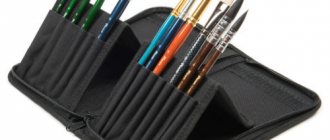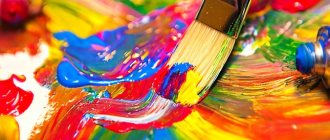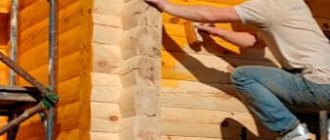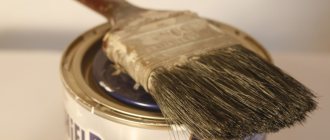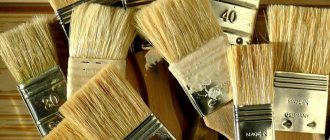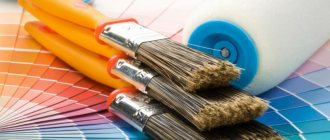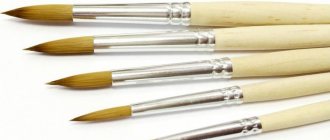6 brushes, different bristles. Review of brushes with different bristles, as well as palettes for painting. Which brush is better: squirrel, goat, kolinsky, pony, bristles or synthetic?
Which brushes are ideal depends on the quality of the brushes, paints (watercolor, oil, gouache, etc.), and the habits of the painter.
Squirrel brushes are the softest and most flexible. Colonel is soft, but elastic, it is tougher than squirrel. Modern synthetics are close in quality to columnar. It does not wear out as quickly as natural bristle brushes, and is even more convenient to use because its bristles are smoother. Most artists prefer to work with natural brushes, but synthetic brushes are also great for children’s painting.
To paint with watercolors, use brushes: squirrel, kolinsky, synthetic.
Kolinok is suitable for any style of painting, but it is also one of the most expensive. If you are in doubt about which brush to choose, you can use Kolinsky.
Squirrel
good for watercolors, synthetics - for acrylic painting. The tip of the squirrel hair brush is sharp and has the same fluidity control as a kolinsky brush, but is not as elastic as a kolinsky brush.
- Catalog of painting brushes - choose!
Pony
Usually they take it when it is not possible to take a weasel or a squirrel. Ponies are tougher than squirrels, they are closer to the column.
Pig bristle brush
Best suited for acrylic and oil, it allows you to work even with very thick paint.
Badger brush
good for soft paints, it is very easy to work with.
Sable
In terms of properties, it combines the kolinsky and the squirrel; number 2 can be used to paint both miniatures and large works.
Nylon bristles (synthetic)
Not suitable for watercolor, but great for acrylic.
The brush should not be very soft, but not too hard.
Squirrel brushes
The traditional, well-known brush is a squirrel brush, it is soft, thin and elastic, the strokes are juicy and bright. It usually consists of a wooden stylus and a galvanized braid that clamps the squirrel's hair. Brushes with different bristles.
The squirrel brush holds its shape perfectly, does not break, absorbs moisture well and is easy to clean under running water. When in contact with paper and other surfaces (porcelain, earthenware, wood), the hairs do not separate and lead a clear line, without “stripes”.
The most valuable among artists are brushes made from the upper part of the tail of a Siberian squirrel. The best hair is in the tail
whites, the hairs are the longest there.
Squirrel fur has good moisture retention properties, which makes it different from kolinka hair when working with watercolors and tempera paints. When wet, a squirrel brush gathers into one dense bunch, which is suitable for painstaking contour work. It can be kept in water for a long time.
Squirrel brushes are mostly round, but squirrel brushes can also be used to make brushes of other shapes.
So: squirrel brushes are used mainly for working with watercolors and water-based paints
. Squirrel brushes are not suitable for oil paints; they are very delicate and immediately begin to peel off from the solvent.
Squirrel brushes need to be looked after, washed after use, dried, and put in a box.
Classification by cutting quality
The quality of the material from which the handle is made affects the comfort of work. The handle of a brush is no less important than its bristles. The ideal option is a moderately long handle made of wood and coated with paint or varnish.
The varnish provides a kind of protection during work.
Trapped moisture and paint will not prevent the artist from holding the brush comfortably in his hand, and thinners will not cause damage to the wood. Excess dried paint is removed from the handle by washing it in water and laundry soap. As a last resort, you can always sand the shaft with fine sandpaper and re-varnish it. The protective layer does not prevent damage to the shaft.
Any cutting can become deformed or deteriorate over time, as the varnish gradually cracks and the integrity of the protective layer is compromised.
The main reason for brush handle damage is improper storage conditions.
The instrument should not be left in water for a long time, and especially not in thinner. A deformed rod is not only uncomfortable to hold in your hand. During the work process, chips from the surface fall onto the canvas.
Column Brushes
The kolonok is an animal from the weasel family, its fur has excellent properties - it is soft and elastic. The bristles of the kolinsky brush adhere perfectly to water, improve the flow of paint, and are suitable for working with watercolors (including professional ones).
The core brush is the leader among brushes. The hair of kolinsky brushes is thin, elastic and has a conical shape. The paint flows from the tip of the brush in a continuous stream and with the best consistency. They are distinguished by a combination of elasticity and elasticity, at the same time they remain soft. From top to bottom, in the photo brushes: nylon 7, goat 7, synthetic 6, synthetic 5, kolinsky 4, squirrel 7.
Column brushes are designed for artistic work with watercolor, oil, tempera, gouache and acrylic.
. In oil painting they are used for small details. There are round and flat.
But who is this speaker? Few have heard of this animal.
The kolinok (lat. Mustela sibirica) is a valuable fur-bearing commercial animal, from the genus of weasels and trochees, its fur is highly valued, and long hairs from the tail are used for artists’ brushes. The fur of the kolinok is very thick, soft, warm, and lush.
Kolonok is a red animal, smaller in size than a cat, flexible, and has a black “mask” on its face. He hunts relatively large animals: hares, black grouse, wood grouse. It does not consume plant foods; in extreme cases, it can feed on insects. All winter he sits in a hole, moving, if necessary, under the snow. In the snow tunnels, the kolonok catches voles. He stores food for the winter and sets up entire warehouses.
Winsor & Newton Series 7 brushes (see brush catalogue) are the highest quality kolanka brushes available. The name of the series comes from 1866, when Her Majesty Queen Victoria ordered W&N to produce brushes for her of the best quality, her favorite size No. 7. As a result, Winsor&Newton named a whole series of brushes “Series7” in honor of this memorable event. These brushes are handmade
.
They will give you a unique pleasure from working with watercolors, because they are made by professionals from the best materials and according to the best traditions, by hand. True, their price is... very high, like a king
.
Brushes “Series 7” from Winsor&Newton, columns.
Recommended Manufacturers
As in the case of paints, brushes for painting and drawing also have their own TOP manufacturers:
- Da Vinci is a European brand of premium brushes.
- Faber-Castell is the oldest office supply company.
- Pinax is another well-known brand that came to Russia not so long ago, but has already established itself as a manufacturer of excellent quality brushes.
- Escoda is a Spanish brand, quite expensive among others, since each brush is created by hand.
- Malevich is a Russian brand of inexpensive and high-quality brushes.
- Roubloff - good, high-quality brushes, sold in almost every art store
Pony brushes
Unlike ordinary horses, which have hard hair, pony hair (from the mane and tail) is soft, so it is used to make tassels. Scottish pony hair is especially valued for brushes. The pony brush hair is of medium hardness, closer to soft.
The hairs of a pony's brushes are somewhat thicker than those of a squirrel, the distance between the hairs is greater, so such a brush takes up less water than a squirrel or column brush. Gathers into a cone shape, not too elastic.
Ideal for beginning artists and often used in children's educational institutions.
Advantages: reliability, durability (strong, thick hair).
Used mainly for paints: watercolor, gouache, tempera, as well as glue and cosmetic purposes
.
Often used by preschool and primary school children.
Pony brushes absorb paint well, but they don’t give off paint as readily as they absorb it.
Checklist for beginning artists: how to choose brushes for acrylic paints
Follow these rules and you will definitely not leave the store empty-handed:
- Check the metal clip - it should be well attached to the handle;
- Look at the pile - it should lie flat, hair to hair and not bristle;
- If the store has such an opportunity, ask the seller to check the brush in use; perhaps they have tester brushes. And if this is not possible, you can always order high-quality brushes in my online store;
- Just hold the brush in your hands and imagine how you paint a picture with it. Are you comfortable holding it? Then feel free to take your new brush to the checkout!
Bristle brushes
Bristle brushes are made from selected pig ear hair. Bristle brushes are used for professional watercolor painting on paper with a rough texture, on canvas.
Bristle brushes are especially convenient for drawing contours and creating contrasts; the hairs should not bristle.
The best bristle brushes are made from the hair of the Chinese Angking hog. The elastic, strong bristles of this animal (hair reaches 20 cm) are subjected to special processing - the bristles are boiled and bleached, and only the white hair is used to make professional brushes.
In addition to elasticity, bristle brushes have another important feature: the split tip of the pig's hair contributes to good fullness of the brush and its even application to the surface. They wear out over time, but are easy to replace because... they are inexpensive.
There are both flat and round, used for working with oil, acrylic paints, and gouache using dry techniques.
.
Pile length
The long bristle of the brush is convenient for working on sketches, when the artist applies strokes with free movements with a large amplitude. Gradually he moves to brushes with shorter tufts.
The “poke” method of applying strokes is interesting. For this method, very old brushes with fairly worn bristles are used. Artists call these brushes “splay brushes.”
It is believed that buying brushes with short bristles is not justified, since long bristles wear out over time.
Some craftsmen trim the bun at their own discretion. In synthetic bundles, wear occurs more intensely, especially if the dye is poorly washed and accumulates at the base of the hairs. For watercolors, it is better to buy brushes with long bristles.
A bristle tuft will allow you to work with thicker paints. For those who do not want to spend money on buying a new bristle brush, there is a special life hack for resuscitating bristles. The hairs inside the clip are glued into a bundle using rosin, which melts well at elevated temperatures. This resource can be used for your own purposes.
The base of the brush is heated on the open flame of a burner or candle, and after the rosin has melted, the bristles are pulled out from the holder using pliers. It is important here not to overdo it and not to pull the hairs completely out of the clip. Usually it is possible to lengthen the beam by 2–3 cm.
Synthetic brushes
Synthetic brushes are an analogue of natural brush in terms of rigidity and elasticity, and in price - an order of magnitude cheaper. The elasticity of the hair is even higher than that of kolinsky, however, synthetics are inferior to kolinsky in terms of filling the brush with water and the volume of absorbed paint. High quality painting brushes.
With synthetic brushes you can draw clear and even lines.
Synthetic brushes are made from nylon, polyester and other fibers
.
The standard thickness of brush hair is 0.08 mm, but there are other options: with thick hair, the elasticity of synthetic hair is close to bristles, but the shape and water-repellent properties are retained, and with thin hair, a synthetic brush absorbs more water and it becomes softer, close to kolinsky hair .
The quality of synthetic brushes made in Japan is highly valued; they produce fiber using the drawing method; the brush hair is not cut, but pulled at a certain angle. Such brushes are often called artificial kolin, they are resistant to acids and caustic liquids, so they can be used for glue, and they are not afraid of thinners.
Synthetic hair based on nylon
- it is hard and does not release water, it is not suitable for watercolor painting, but
it is excellent for oil paints and acrylic
Synthetic hair based on polyester fibers
has a capillary effect, which allows you to use such brushes even in
watercolors
.
In terms of resistance to mechanical stress, synthetic brushes are inferior to natural ones, because... the fibers quickly wear out and become soft. But such brushes are inexpensive, professional artists buy synthetics in large quantities, and these brushes are very suitable for children’s painting.
Important assistant
It is customary to pay a lot of attention to brushes, and this is not surprising, because it is with them that you will create your masterpieces! That's why I tell you so carefully how to choose, store and care for these furry helpers.
In general, I believe that an artist should have many brushes. What does it have to do with the most different ones! After all, you never know what kind of brush might come in handy if you love to draw. Acrylic, oil, watercolor, arts and crafts, as well as glue, primer, varnish - for all this you need your own special brush, or better yet several.
Don't skimp on brushes, but rather choose them wisely!
But today we will talk about which brushes are best suited for acrylic paints. After all, as with any other paint, not all brushes and not all materials are suitable for acrylic. Of course, if you want, you can paint with any brush at all, but this will either significantly complicate the whole process, or simply ruin the brush.
So, let's figure it out so as not to make a mistake with the choice.
What does the number on a paint brush mean?
The number means the width, diameter of the brush in mm. This is the size of the brush - from thin “zero” to thick brushes 10, 12... Round brushes are collected in a round clip and, depending on the diameter of the clip, the size is numbered, starting from 0 to 20 and above, in increments of 1 mm. Round brushes can be either regular or with long bristles (one and a half times longer than the standard). Palette.
Artistic brushes for painting come in round, flat and fan shapes.
Zero brushes are the thinnest, they are assembled from literally several hairs, and are used for drawing small details, for miniatures.
Zeros are usually made from kolonka; squirrel zeros are almost unsuitable for work, they are too soft.
There are brushes numbered 00 (two zeros), but such brushes are difficult to work with because the paint does not stick to one hair. At the same time, if the brush is of high quality and correctly assembled, then with number 2 it is quite possible to paint miniatures.
The difference between brush numbers 0 and 1 is insignificant, and given that the brush tends to wear out, it is better (especially for a child) to choose brush 1, and then it will turn into number 0.
It is better to use a squirrel brush starting with size 2 and above, optimally 3-4, for watercolors 4-6.
A flat brush is a regular round brush, only flattened. Sizes for flat brushes are numbered only in even numbers.
– the smallest size is 2, then 4, 6, 8, 10, 12, large ones 16, 18. The fact is that when you squeeze a round brush with number 1, it turns into a flat 2 mm. When a round two is compressed, a flat 4 is obtained. But when flattening, it is not always possible to make strictly 4 mm from No. 2; it may turn out to be 3 or 3.5 mm. To avoid having too many sizes of brushes (there is no point in this), flat brushes were graduated by even numbers; all inaccurate ones are assigned to the nearest size.
Flat brushes include a flute - this is a wide flat brush, number 20 (width 2 cm). They are used for large works - for example, when painting iconostasis, in wall paintings.
Handle length
Despite the fact that the main working element of the brush is the hair tuft, the length of the handle plays a fundamental role in the choice. This criterion provides another type of classification.
Experienced painters always choose a tool with a wooden handle. Plastic does not withstand the effects of thinner, and it can also become deformed when washing the brush, especially when working with oil. There is no single theory for selecting handle length.
In this matter, everything depends on the preferences of the artist himself. But the weight of the hand also depends on the length of the shaft, and, as you know, a tool that is too light or too heavy only brings discomfort to the work process. When choosing a brush, it is recommended to hold it in your hand and evaluate its grip and weight.
It should be remembered that brushes with a short shaft fit into any pencil case.
Long brushes look more aesthetically pleasing, and the shaft itself serves the artist as a measuring tool. To summarize this issue, we note that long brushes are good when painting while standing. While sitting, the artist is forced to keep the brush closer to the clip, and the long shaft creates a counterweight and causes external forced vibrations to occur.
Master class: painting with gouache
A simple example of how to make a real picture (winter tree) step by step:
- You should start with the background - snow, sky. In the area where there will be a tree, you need to make the sky brighter.
- After drying the background, draw a tree with branches with a pencil. Then draw the contours with paint, drawing well the trunk, brown branches, making them white with snow at the tips. More small branches should be drawn on the main branches.
- Make details. To do this, lighten the small branches and “strengthen” the trunk with dark brown, black gouache. Add gray shadows to the branches.
- To create a brighter picture, you can add pink and blue to the background - like shades of the sky.
To decorate the picture, you can also draw animals, birds, a garland - whatever your imagination suggests. Gouache will quickly become your favorite material for creativity, because working with it is easy and fun!

